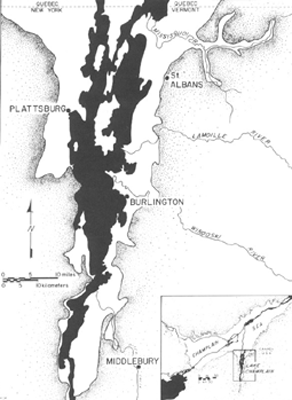LITHOLOGY AND SEDIMENTATION
Lake Champlain Lithology
![]()
 |
An excellent example of a proglacial lake in the southern Champlain Sea basin is the area in Vermont that presently hosts Lake Champlain. Shown in the map to the right (Hunt), is the current location of Lake Champlain and its geographical location relative to that of the Champlain Sea. The presence of this proglacial lake, named Lake Vermont, is due to a reduced marine influx and a great supply of glacial meltwater as the Laurentide Ice Sheet passed over the region. The study of this area is very useful to establish the transitions from freshwater to marine, and back to freshwater environments. Shown in the table below (Hunt), are the different lithologies associated with these different stages, the Lake Vermont stage, the Champlain Sea stage and the Lake Champlain stage. |
Postglacial Stratigraphy of Lake Champlain Sediments
|
Sedimentary
Units |
Biological
Content |
Lithological
Characteristics |
|
LAKE
CHAMPLAIN (Freshwater) |
Ostracodes, bryozoans,
rhizopods, arthropods, diatoms, pollen, plant fragments |
Olive grey to grey-brown
organic mud with mottling 0 ö 24 meters |
|
CHAMPLAIN
SEA (Marine) |
Foraminifera, ostracodes,
gastropods, pelecypods, sponges, holothurians, otoliths, pollen |
Dark grey silty clay 0 ö 12 meters |
|
LAKE
VERMONT (Freshwater) |
Pollen, plant fragments |
Dark grey clay with
alternating brown and grey bands 0 ö 200 (?) meters |
![]()